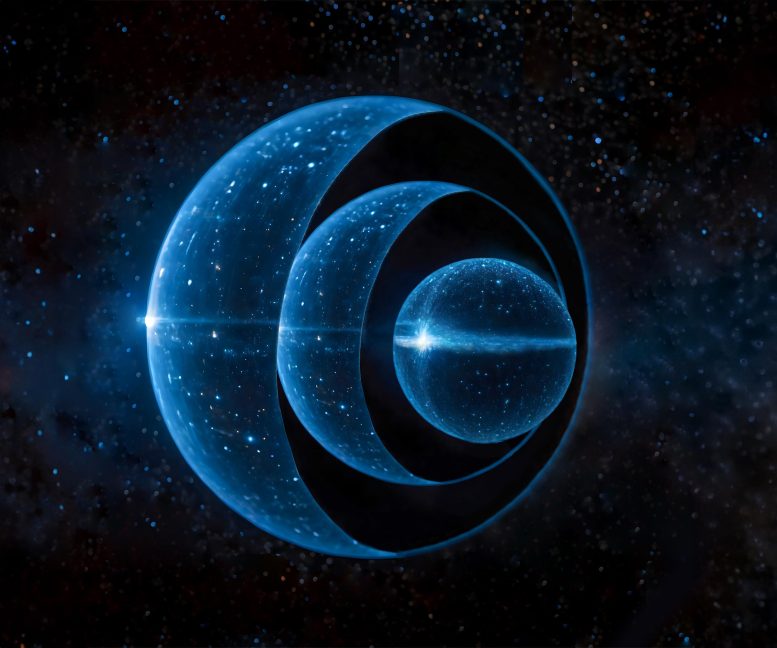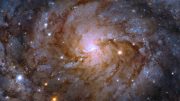
According to findings by physicists at Goethe University Frankfurt, a gravastar could look like a matryoshka doll. Credit: Daniel Jampolski and Luciano Rezzolla, Goethe University Frankfurt, edited
Physicists at Goethe University Frankfurt find new solution to Einstein’s general theory of relativity.
If gravitational condensate stars (or gravastars) actually existed, they would look similar to black holes to a distant observer. Two theoretical physicists at Goethe University Frankfurt have now found a new solution to Albert Einstein’s theory of general relativity, according to which gravitational stars could be structured like a Russian matryoshka doll, with one gravastar located inside another.
The Black Hole Enigma
The interior of black holes remains a conundrum for science.
In 1916, German physicist Karl Schwarzschild outlined a solution to Albert Einstein’s equations of general relativity, according to which the center of a black hole consists of a so-called singularity, a point at which space and time no longer exist. Here, the theory goes, all physical laws, including Einstein’s general theory of relativity, no longer apply; the principle of causality is suspended.
This constitutes a great nuisance for science: after all, it means that no information can escape from a black hole beyond the so-called event horizon. This could be a reason why Schwarzschild’s solution did not attract much attention outside the theoretical realm for a long time – that is, until the first candidate for a black hole was discovered in 1971, followed by the discovery of the black hole in the center of our Milky Way in the 2000s, and finally the first image of a black hole, captured by the Event Horizon Telescope Collaboration in 2019.
Gravastars: A Theoretical Alternative
In 2001, Pawel Mazur and Emil Mottola proposed a different solution to Einstein’s field equations that led to objects which they called gravitational condensate stars, or gravastars. Contrary to black holes, gravastars have several advantages from a theoretical astrophysics perspective. On the one hand, they are almost as compact as black holes and also exhibit a gravity at their surface that is essentially as strong as that of a black hole, hence resembling a black hole for all practical purposes. On the other hand, gravastars do not have an event horizon, that is, a boundary from within which no information can be sent out, and their core does not contain a singularity. Instead, the center of gravastars is made up of an exotic – dark – energy that exerts a negative pressure to the enormous gravitational force compressing the star. The surface of gravastars is represented by a wafer-thin skin of ordinary matter, the thickness of which approaches zero.
Theoretical physicists Daniel Jampolski and Prof. Luciano Rezzolla of Goethe University Frankfurt have now presented a solution to the field equations of general relativity that describes the existence of a gravastar inside another gravastar. They have given this hypothetical celestial object the name “nestar” (from the English “nested”).
The Concept of Nestars
Daniel Jampolski, who discovered the solution as part of his Bachelor’s thesis supervised by Luciano Rezzolla, says: “The nestar is like a matryoshka doll,” adding that, “our solution to the field equations allows for a whole series of nested gravastars.” Whereas Mazur and Mottola posit that the gravastar has a near infinite thin skin consisting of normal matter, the nestar’s matter-composed shell is somewhat thicker: “It’s a little easier to imagine that something like this could exist.”
Continuing Legacy and Future Prospects
Luciano Rezzolla, Professor of Theoretical Astrophysics at Goethe University, explains: “It’s great that even 100 years after Schwarzschild presented his first solution to Einstein’s field equations from the general theory of relativity, it’s still possible to find new solutions. It’s a bit like finding a gold coin along a path that has been explored by many others before. Unfortunately, we still have no idea how such a gravastar could be created. But even if nestars don’t exist, exploring the mathematical properties of these solutions ultimately helps us to better understand black holes.”
Reference: “Nested solutions of gravitational condensate stars” by Daniel Jampolski and Luciano Rezzolla, 15 February 2024, Classical and Quantum Gravity.
DOI: 10.1088/1361-6382/ad2317









Mental masturbation on full display!
Just because something can be imagined and”proved” mathematically doesn’t mean it exists outside the mind of the person who imagined it.And the converse ; just because something cannot be imagined, doesn’t mean it can’t exist)..)
Pretty poor reading comprehension from you Brian. I didn’t see anywhere in the article they claimed it was a proof, just a model. Isn’t mathematical modelling the basis of theoretical physics? You need hypothesis like this to formulate the parameters of experiments that can be used to prove or disprove it. By your same description, the “mental masturbation” of Einstein, Newton and every other theoretical physicist that came before was equally a waste of time.
I think that we should respect one’s idea and think on it with a great research. It may create a new era and if we not get the answer we want still we can explore new things